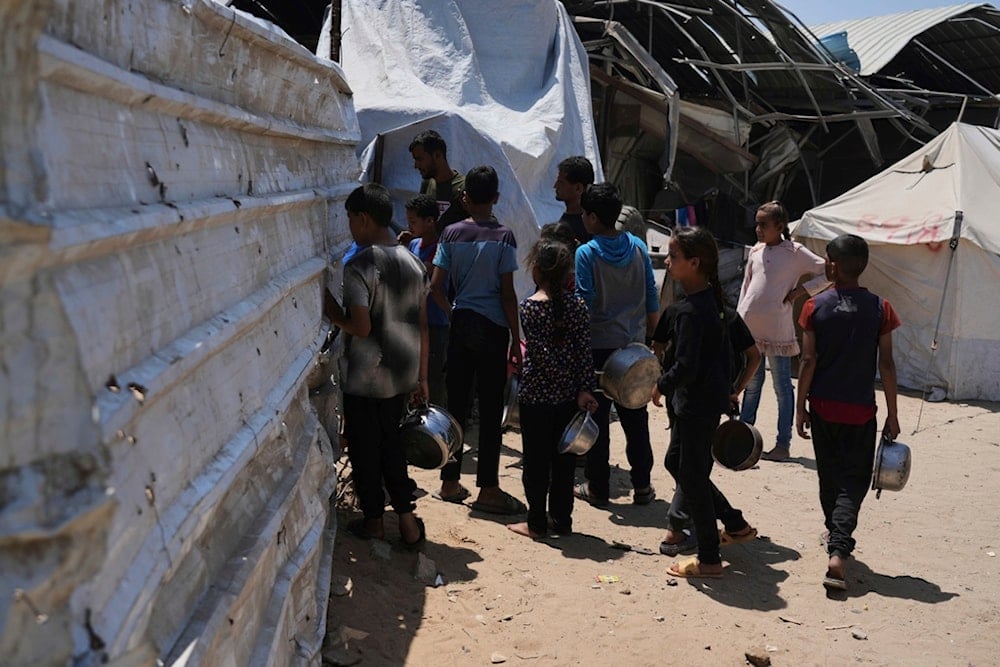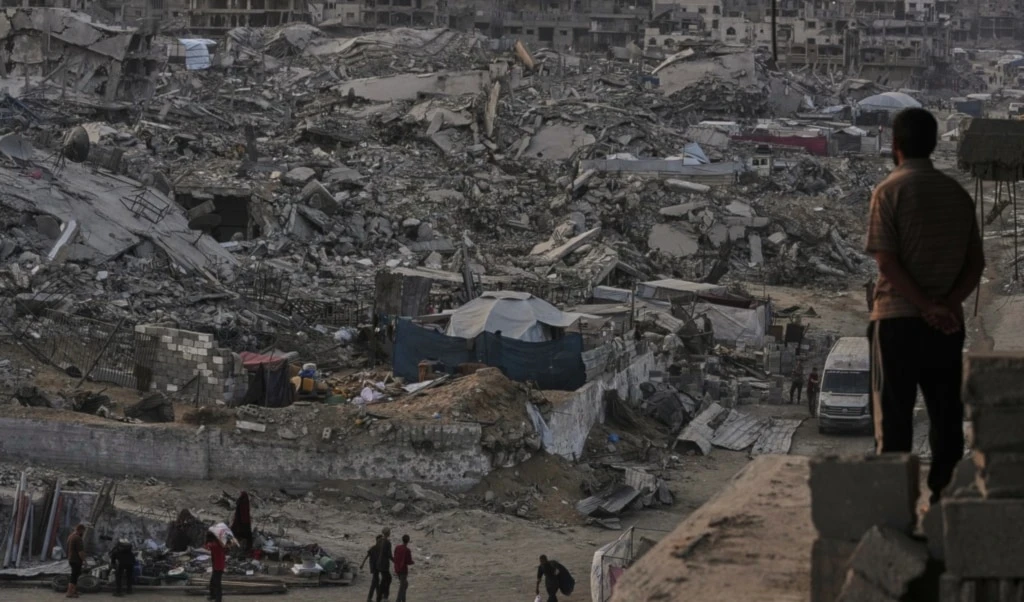US-backed Gaza aid plan relies on mercenaries, sparks outcry: FT
A US-backed Gaza aid plan involving private contractors and sidelining the UN has drawn sharp criticism over its opaque structure and potential for forced displacement.
-

Displaced Palestinians line up to receive donated meals from a community kitchen at a tent camp in Gaza City on Wednesday, May 21, 2025 (AP Photo/Jehad Alshrafi)
The Financial Times on Wednesday revealed that dozens of foreign private contractors have arrived in occupied Palestine to support the rollout of a contentious US-endorsed aid initiative for Gaza, one that could sideline the United Nations and reshape how assistance is delivered amid one of the globe's most dire humanitarian emergencies.
In response to international outrage over its blockade of Gaza, which Israeli Prime Minister Benjamin Netanyahu admitted had driven the population to the brink of starvation, "Israel" recently allowed over 90 trucks into the territory. However, officials have described this move as a temporary measure until a new aid framework, one championed by US President Donald Trump's administration, is put in place by the end of the month.
Aid Controversy
At the center of this approach is the little-known Gaza Humanitarian Foundation (GHF), a Swiss-registered entity tasked with managing aid distribution through centralized hubs in southern Gaza, under the watch of Israeli forces and private security. Under this system, the UN and other groups would be required to operate through these designated points, compelling Palestinians to make long and potentially dangerous journeys to access food and medicine.
Since its proposal earlier this May, the initiative has encountered a series of problems. Individuals familiar with its development told the Financial Times that the project, which reportedly received informal guidance from former UK Prime Minister Tony Blair, is not equipped to meet the needs of over 2 million Gazans.
The United Nations, which has historically led aid operations in Gaza, strongly criticized the initiative. One official dismissed it as a "fig leaf" for forced relocation. Adding to the confusion, an individual listed as a GHF board member in internal documents said they had no role in the organization. "The entire thing turned toxic," said a source involved with the effort.
GHF has claimed it intends to distribute 300 million meals in the first three months of operations, at a cost of $1.30 per meal, including expenses tied to hiring security personnel. Yet questions remain about the foundation's funding.
Three sources indicated that no external donors had committed funds as of last week, casting uncertainty over how the project would be sustained. One person close to GHF insisted, however, that at least $100 million in pledges had been secured, without naming contributors.
False Affiliations
Notable figures from the humanitarian world were initially associated with the project. Blair reportedly discussed the plan with David Beasley, the former World Food Programme chief. Beasley's potential involvement was seen as a boost to the project's credibility, though he did not respond to requests for comment. While not formally part of GHF, one insider said Beasley remains in informal contact with the group.
Nate Mook, former CEO of World Central Kitchen, was described in GHF documents as "an invaluable board member," but told the Financial Times, "I'm not on the board," and declined to elaborate. A GHF representative explained that the reference appeared in an internal draft that was inadvertently leaked.
Concerns are also mounting over the foundation's organizational opacity. GHF is affiliated with a Swiss entity registered by an Armenian national lacking any background in humanitarian work, and reportedly also includes a US-based arm whose details remain undisclosed.
Read more: Ex-Israeli PM admits Israeli actions in Gaza 'close to war crimes'
Recent Israeli news coverage has shown photos of uniformed foreign contractors arriving in the country and preparing to secure aid distribution points. Two American firms, Safe Reach Solutions and UG Solutions, have been named as partners. Both had previously managed a smaller checkpoint operation during a brief ceasefire earlier this year. Neither company responded to inquiries.
GHF's executive director, Jake Wood, a former US Marine and founder of disaster response group Team Rubicon, defended the plan. "We are committed to delivering aid in a humanitarian manner, not militarised," a GHF spokesperson stated. "The distribution will be managed exclusively by civilian teams." They added, "Now is the time to collaborate on this effort. We understand some of [the UN] concerns, but this new mechanism is the method to get life-saving assistance to Gazans in a way that Israel will allow."
The Tony Blair Institute denied that Blair or the institute had any formal advisory role in the project.
🔴 Des membres de la société américaine, « Gaza Humanitarian Foundation » (Fondation humanitaire de Gaza), filmés en Israël lors de briefings médiatiques, portant des gilets pare-balles et étant armés. Certains membres sont d’anciens soldats d’unités d’élite américaines, ayant… pic.twitter.com/mysKIobQlK
, Shanna Messaoudi (@Shanna__Bylka) May 19, 2025
Relief agencies have so far declined to take part in the effort, criticizing the centralization of distribution centers, mainly near the Egyptian border. The move, they argue, could result in the mass movement of desperate civilians toward the south. Israeli Finance Minister Bezalel Smotrich has previously described military operations in Gaza as part of an effort to expel the population and "change the course of history."
UN aid chief Tom Fletcher told the Security Council last week, "It makes starvation a bargaining chip."
Militarized Relief
GHF has since attempted to adjust its proposal, requesting authorization from "Israel" to establish aid sites in northern Gaza and making claims about pledges to protect recipients' personal data. It also expressed willingness to include non-food items such as cooking and medical supplies, though it remains unclear if Israeli authorities will approve these revisions.
Both US and Israeli officials maintain that this approach is necessary to prevent aid from falling into the hands of Hamas, a key justification for the ongoing siege. The concept mirrors earlier Israeli military strategies to create "sterile" zones for aid distribution, free of Hamas presence.
This stands in contrast to the model advocated by the international humanitarian community, which favors widespread, localized distribution points. Philippe Lazzarini, head of UNRWA, stated his agency had found no significant evidence of Hamas diverting aid, attributing theft to widespread desperation and food shortages.
Officials involved in the GHF plan have also raised internal concerns over the potential conduct of private contractors, particularly regarding their rules of engagement should violence erupt at the distribution centers, each expected to serve up to 300,000 people.
Despite widespread opposition, the US government remains firmly behind the initiative. "President Trump called for creative solutions that would secure peace, protect Israel, leave Hamas empty-handed, and deliver life-saving assistance to the people of Gaza," a State Department spokesperson said. "Due to his inspirational leadership, we are steps away from a major win for everyone."

 6 Min Read
6 Min Read










